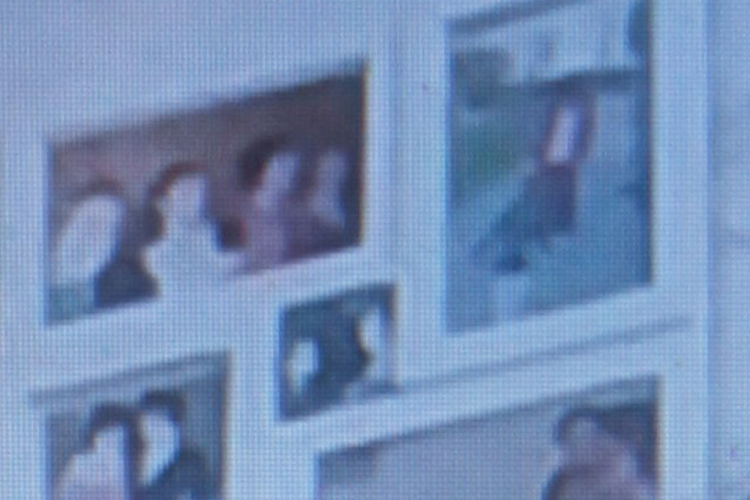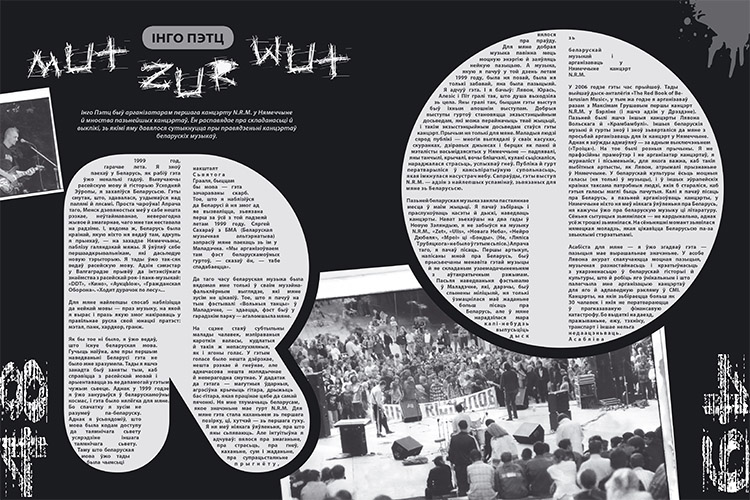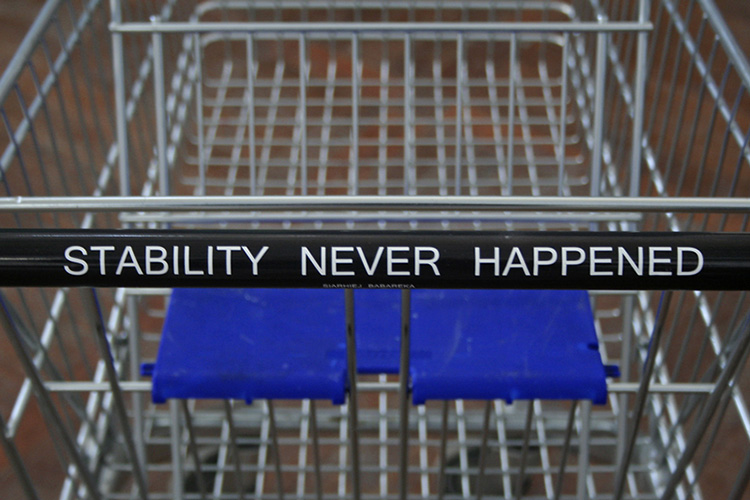Аўтар: Taciana Arcimović, 14/01/2014 | ART interview
Uladzimir Parfianok: Life with Photography

Uladzimir Parfianok / Persona non grata series (launched in 1988)

Uladzimir Parfianok / Persona non grata series (launched in 1988)

Uladzimir Parfianok / Persona non grata series (launched in 1988)

Uladzimir Parfianok / Persona non grata series (launched in 1988)

Uladzimir Parfianok / Persona non grata series (launched in 1988)

Uladzimir Parfianok / The last days of the past war series (1945-1991)

Uladzimir Parfianok / The last days of the past war series (1945-1991)

Uladzimir Parfianok / Garden of stones series (1991)

Uladzimir Parfianok / Garden of stones series (1991)

Uladzimir Parfianok / Garden of stones series (1991)
pARTisan #24’2013
According to Belarusian famous photographer Uladzimir Parfianok, he made his first self-portrait in quite comfortable environment in the students’ hostel, with the broken wall prepared to be tiled as a background. The portrait shows a la dandy chap from Kurasouśćyna dressed in a striped robe near the broken wash basin and chipped wall. This is how a “personality” expressed his right for “beauty” even in the ugliest environment.
Apart from his own art, in 1996 Parfianok started to work as a curator of other photographers within the frameworks of exhibition projects in “NOVA” gallery. There are more than 20 project series in his portfolio — there has been a photo a day. Piles of these photos have actually formed a diary of the epoch, or the edge of epochs, the new reality where only Uladzimir Parfianok’s lifestyle remains unchanged. This lifestyle is photography.
− Uladzimir, nowadays there is a great variety of forms, kinds and fields of photography. Which kind of photography appeals to you?
Uladzimir Parfianok: For me there is only one criterion – an emotional feedback. Photography is not just a kind of art with a specific function of registering the reality, which none of other kinds of traditional visual art is capable of. Photography can also be a very personal and emotional reflection of the reality.
If someone ever masters the language of photography to be able to express their emotions and provoke feedback, this is what I call good photography.
− You have stressed the importance of technology and form of photography. What does it actually mean nowadays when everything is changing so fast?
Ul. P.: A modern photographer is free to choose any tool to implement his/her ideas. I quite like experimenting with photos myself. One of my recent projects, for instance, is connected with taking photos of live TV broadcast of the Independence Day in Minsk. I spent two hours in front of the TV screen making digital shots of everything that was being broadcast during the celebration. Honestly, I had more advantages than I would have if I had been making a photo report from the site of events. I would have been restricted by a particular place of taking photos. It’s no secret that at such official celebrations all moves of photographers are tightly regulated. But in a TV broadcast, one can see images from a dozen TV cameras. So, what was left for me to do was only make my own visual story.
− Everyone knows that 00s in Belarus are distinguished by disputes about whether use film or digital cameras in photography. What’s your opinion about this?
Ul. P.: Yes, it’s true, everyone was arguing at that time. Those who had an experience in traditional photography and understood what was happening inside the camera saw that a digital camera didn’t allow to do everything. As far as I’m concerned, I got my first digital camera in 2003. It enabled me to photograph fast and almost without any limitations, but it could hardly be called art photography.
The more digital technology there was, the less time I spent in the dark room where I used to print my photos, or, actually, create them.
Frankly speaking, I do regret it. With time, there appeared screen presentation of photos which began to displace paper-based prints. Fast Internet contributes to such a profanation of photography in terms of a print art. It is becoming evident that film and digital photography, namely, a photo image on the screen and photo image printed on paper, are drifting more and more apart into parallel dimensions. It is very likely that digital photography fits to the flat screen of a computer monitor, while traditional photography with film developing and making prints is a visual tool suitable for creating art.
− The results of total democratization of photography can be daily observed on the Facebook in our friends’ stream. Some people are very critical to this endless stream of images portraying fragments of the most primitive daily routine. What’s your view on this?
Ul. P.: Naturally, I’m tired of theses endless images of kittens-flowers-holidays, but I think amateurs shouldn’t be banned to take pictures of what they usually do. The visual language of photography develops due to this army of amateurs who master the trade. They are not burdened with knowledge of the history of art and rules of objects arrangement, but they sometimes have an amazing intuition. Sometimes the discoveries made by amateurs can have a strong influence on professional photography. This was the case 100 years ago when photography left studios and went to the city streets thanks to a portable “Kodak” camera designed especially for amateurs. Photography recovered from shock of how and what they shot very fast. Professional photography very soon used the energy, innovations and fantasy of photo amateurs, and discovered a new authentic visual language different form the previously borrowed language of traditional visual arts. Therefore, amateurs make discoveries which professionals make use of. These two fields, namely, the professional and amateur, can’t live without each other. As regards the Facebook stream, one should only change setting according to their preferences and delete those who disturb and bother.
I like looking at the photos taken by amateurs because I know that I can find something valuable and useful for me.
By the way, for the unofficial 53 Venetian Biennale held in Moscow in 2009, I made a project Photographs from The Recycle Bin. I mean a computer dump where we throw various spoilt files, including pictures. The thing is that I, like all of us, have my own attitude to what I do as well as understanding of my creative style. The rest of it I usually throw away in the rubbish bin. Once I realized that it was a mistake and I checked the bin, and restored some of the things that had been kept there for years, such as some plot stereotypes, mistakes in the composition, ridiculous pictures, etc. Thus, I have formed an array of reincarnated digital photos out of my rubbish. The most remarkable thing was that I found a number of unexpected and amazing photos which otherwise would have been destined to disappear. It seems to me that in a couple of years I will also find there something interesting which I have failed to notice in the beginning.
− You said earlier that your topics haven’t changed. How did it happen?
Ul. P.: I guess that there is a general trend in searching for topics which allow distinguishing between a beginner and a photographer who has long been working. A characteristic of novices is that they work with the so-called “close circle”. While taking pictures of nature, friends, classmates, group mates and their favorite people they don’t leave their comfort zone. Photography is different from any other artistic practices, since it requires a real contact with reality. To make a portrait, it is not enough to have imagination; a model is needed. It is very difficult to establish a good contact with a stranger; this experience comes with time. It is quite natural that novices choose more comfortable zones. Their first photos can sometimes be quite good, such as a mother’s portrait or a portrait of close people: those who understand “the rules of the game” and allow doing everything with them.
But it is necessary to leave this comfort zone and set more challenging tasks.
They should not only learn technologies, but also work on a wider area: family life, life of a particular group of people, and society. Unfortunately, many photographers remain on the level of taking pictures within their comfort zones. They think that everything is great, but the truth is that they can’t overcome their fear and go outside. I managed to cope with this fear.
− Nevertheless, you made your last project in the comfort zone, in your own room in front of the TV screen.
Ul. P.: Yes, I did. But the topic which I wanted to raise was quite problematic for public exposure. This was another kind of discomfort. I had a choice either to go to the parade and remain tied to one point or shoot the celebration indirectly. Actually, it was a task for the students of our summer photo academy. They had official permissions to photograph this event. But I knew that I would have been restricted if I had gone there. I advised my students not to go to the celebration itself but to photograph the periphery and what was happening there. It is not relevant anymore to take pictures of an event. In the end, someone was photographing what people were doing in the park. Jahor Voinau took a photo of a man washing his car with a TVset nearby broadcasting the parade. It was actually surprising, as in his photo there was almost the similar frame on TV to the one which I shot in my apartment.
Such a mixture of different views of one event gave a more dimensional result. Those who were photographing directly on site of the event had only three plots: planes flying, president’s car arriving and people stands nearby.
− What is, in your opinion, happening to the Belarusian photography nowadays?
Ul. P.: It seems to me that the Belarusian photography is not going anywhere; year by year, decade by decade it is moving around a circle. Unfortunately, there are no environments that would provide for the constant development of photography, where artistic energy of young artists would accumulate and where different generations of Belarusian photographers could have a dialogue. In our country no books on photography are published, no art albums of photography are created. There isn’t any single photo magazine. I can’t remember any significant analytical photo exhibition projects.
In other words, there isn’t anything that would sum up certain achievements in the field of photography. Everyone work for themselves. I think the dominating ideology is the ideology of individualism, or even egocentrism. Earlier, we had been inspired by other ideas, we were discussing our projects at the birth stage, we were helping each other, and the word “competition” was simply irrelevant. And this gave results: there were major exhibitions of the Belarusian photography abroad, there were catalogues, publications, as well as our photographs were bought for collections of foreign museums.
The Belarusian photography doesn’t know where to go. This is also connected with the common problem of nation building, because no clear national idea has appeared so far.
Probably, we have separately learnt to be artists in Belarus, but it is very unlikely that there is a common understanding of what it is like to be a contemporary Belarusian artist and create contemporary Belarusian art which would be interesting beyond Belarus’ borders.
Interviewed by Tania Arcimović. Translated by Sviatłana Sous
Photo by Uladzimir Parfianok / parfianok.iatp.by
Opinions of authors do not always reflect the views of pARTisan. If you note any errors, please contact us right away.






